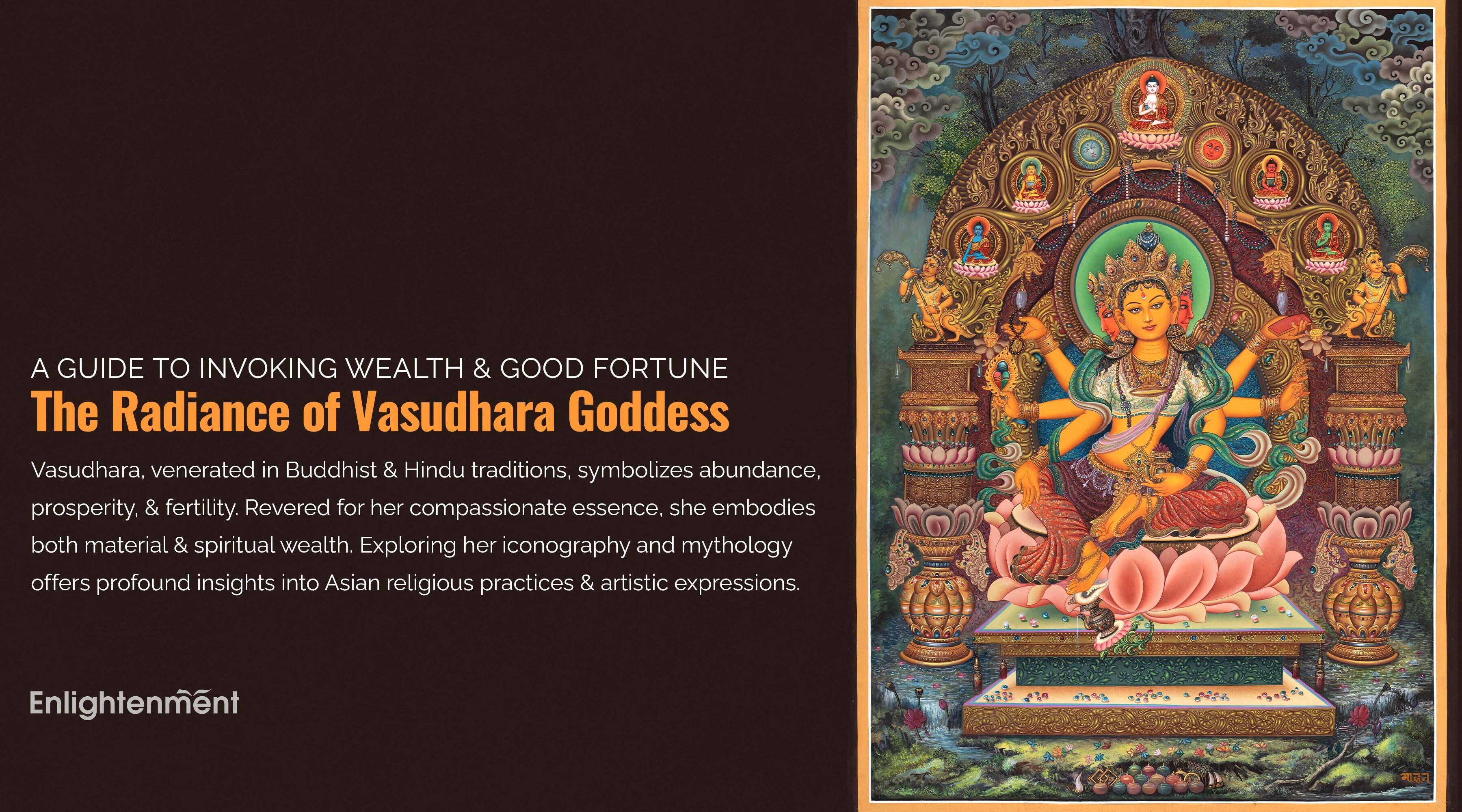Vasudhara, The Goddess of Abundance and Prosperity
Vasudhara, revered in Buddhist and Hindu traditions, embodies abundance, prosperity, and fertility. Revered for her compassionate and nurturing essence, she symbolizes material and spiritual wealth. Delving into her iconography and mythology provides profound insights into Asian religious practices and artistic expressions.
Key Takeaways:
- Vasudhara embodies abundance, prosperity, and fertility in Buddhist and Hindu beliefs.
- Her iconography is rich and varies across cultures, symbolizing various aspects of wealth and spiritual well-being.
- Vasudhara's worship involved unique rituals and profoundly influenced art and literature.
Historical and Mythological Background
Origin in Hinduism
In Hindu mythology, Vasudhara's roots can be traced to ancient Vedic texts, often drawing parallels with Lakshmi, the goddess of wealth and prosperity. This association is apparent in numerous scriptures highlighting her role as a provider and nurturer. While Vasudhara's presence may be less conspicuous than deities featured prominently in epics and Puranas, her subtle yet profound importance shines through daily worship and rituals.
In-depth Analysis of Hindu Texts:
Rigveda and Atharvaveda: References to goddesses representing fertility and prosperity, possibly early forms of Lakshmi or Vasudhara.
Puranas: Later texts where her attributes are more closely aligned with those of Lakshmi highlight the interwoven nature of Hindu deities.
| Aspect | Description |
| Origin | Ancient Vedic text and Puranas |
| Association | Closely linked with Goddess Lakshmi |
| Role | Provider of wealth and nourishment |
Significance in Buddhism
Within the Vajrayana tradition of Buddhism, Vasudhara plays a crucial role, transcending her symbolism of material wealth to embody spiritual abundance. Depicted in Buddhist texts, her presence is intertwined with teachings on generosity and the virtue of giving. Vasudhara's importance in Buddhism surpasses mere iconography; she becomes a living expression of the philosophy of abundance through acts of giving and kindness.
Buddhist Texts and Teachings:
- Sutras and Tantras: These texts often describe her qualities and virtues, emphasizing generosity.
- Teachings and Practices: Buddhist practices involving Vasudhara include meditations and rituals to cultivate a spirit of generosity and abundance.
| Tradition | Role |
| Vajrayana Buddhism | Embodiment of generosity and spiritual wealth |
| Teachings | Emphasis on the virtue of giving and abundance |
Iconography and Symbolism: Attributes and Symbols
Click here to view Vasudhara Gold Statue
Vasudhara's portrayal in art and iconography is diverse and intricate. Typically depicted with multiple arms, each carrying symbolic items such as grains, gold, and occasionally a book, she embodies various facets of prosperity and knowledge. In certain traditions, she is depicted holding a wish-fulfilling jewel, symbolizing the limitless generosity inherent in the universe.
Detailed Iconography:
| Attribute | Symbolism |
| Multiple Arms | Various aspects of abundance and benevolence |
| Objects in Hands | Different forms of wealth and knowledge |
Color and Posture
The color and posture of Vasudhara in diverse depictions carry profound meanings. Rendered in a golden hue, she symbolizes the richness and fertility of the earth. Whether seated or standing on a lotus, her posture signifies purity and spiritual enlightenment.
Color and Posture Analysis:
- Golden Hue: Represents fertility, richness, and the life-giving aspect of the earth.
- Lotus Posture: Symbolizes purity and spiritual awakening.
Cultural and Religious Significance
Festivals and Worship Practices
Vasudhara is venerated through diverse rituals and festivals, particularly in regions where agriculture is integral to daily life. These celebrations serve as religious observances, joyous acknowledgments of the earth's fertility, and expressions of gratitude for her abundant blessings.
Major Festivals and Rituals:
Specific Regional Festivals vary by region but often involve offerings of grains, fruits, and other harvest symbols.
Daily Worship Practices: In Hindu and Buddhist households, daily rituals might include hymns, mantras, and offerings to Vasudhara.
| Festival | Region | Description |
| Specific Festivals | Various parts of Asia | Celebrations of harvest and abundance |
| Daily Rituals | Hindu and Buddhist homes | Offerings and prayers for prosperity |
Influence on Art and Literature
Vasudhara's depiction has ignited a vibrant tapestry of art and literature. She emerges as a nurturing and benevolent deity in paintings, sculptures, and literary creations, frequently encircled by symbols representing abundance and fertility.
Artistic and Literary Representations:
- Art: Sculptures, paintings, and temple carvings depict her in various benevolent postures.
- Literature: Stories and hymns extolling her virtues and benevolence are standard in Hindu and Buddhist texts.
Comparative Analysis: Vasudhara in Different Cultures
Vasudhara's representation and significance undergo intriguing variations across different cultures. In Hinduism, she closely associates with Lakshmi, emphasizing prosperity, whereas in Buddhism, her role transcends to a more spiritual and transcendent nature.
Cultural Variations
Hinduism: Focus on material wealth and prosperity.
Buddhism: Emphasis on spiritual wealth and generosity.
| Culture | Representation |
| Hinduism | Closely associated with Lakshmi |
| Buddhism | Embodiment of generosity and spiritual wealth |
Parallels with Other Deities
Vasudhara shares numerous attributes with deities of wealth and prosperity across diverse mythologies. The resemblances of the Roman Goddess Fortuna and the Greek Goddess Demeter underscore the universal concept of a nurturing and bountiful deity.
Comparative Mythology:
- Lakshmi (Hinduism): Similar roles and attributes represent wealth and prosperity.
- Fortuna (Roman Mythology): Goddess of fortune and abundance, sharing the theme of prosperity and luck.
| Deity | Similarity |
| Lakshmi (Hinduism) | Goddess of wealth and prosperity |
| Fortuna (Roman Mythology) | Goddess of fortune and abundance |
Vasudhara, surpassing religious and cultural confines, stands as a universal symbol of generosity, abundance, and fertility. Her importance in art, culture, and religion underscores a profound human yearning for wealth, encompassing both the material and the spiritual, emphasizing the pivotal role of generosity in attaining genuine abundance.

